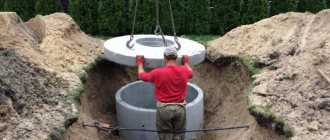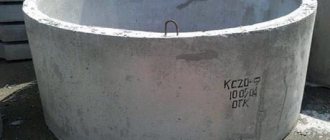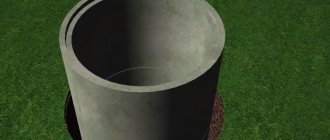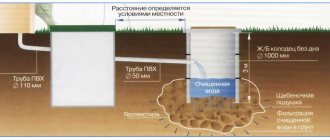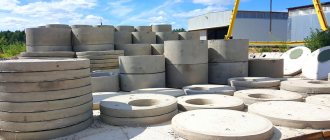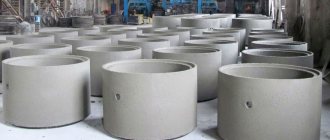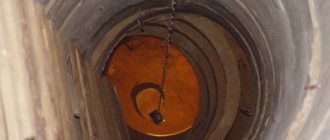How to find out the volume of a ring?
Method number 1 - find out her finger size using your own
- put the jewelry on all the way, remember the place where it fits tightly (to be sure, mark it with a pen);
- measure the girth with a thread or strip of paper;
- using a ruler, calculate the result in millimeters and divide by 3.14;
- the resulting number is the SAME number on your girlfriend’s finger.
Interesting materials:
What are the pineal gland and the diaphysis? What are epithets and metaphors examples? What is the Age of Pisces? What is ERC-20? What is a pop symphony orchestra? What is a standard in physics? What is the etiology and pathogenesis of the disease? What is Eurolighting? What is Europost? What is a factory in programming?
Additional items
To perform calculations and design, it is necessary to take into account all the elements that are included in the design. Wells are not built from rings alone; usually, various additional elements are also used for installation, making it possible to implement any system configuration.
What elements are used in the installation of well structures:
- Bottom plates
– to create a reliable foundation.
- Additional rings
– to obtain the required size of the well, if it is not possible to create it from standard products.
- Floor slabs (aka well covers)
– for covering the top of the well and the space under the hatch.
There are also rings with covers, which represent the combination of a ring and a cover into a monolithic structure in a factory environment.
Covers for wells
The lid is a round plate that covers the ring, with a hole in the center or side. In drainage wells, covers are installed with a hole for a hatch in the center, for other purposes - on the side.
Covers are made from heavy, high-strength concrete of minimum class B15, waterproof and frost-resistant. For installation and loading/unloading, the product is equipped with reinforcement loops.
Bottom plates
These are prefabricated reinforced concrete elements for the installation of underground engineering structures and communications. The plates become the base for the chamber, and rings are mounted on top of them. Thanks to the bottom slabs, it is possible to ensure the tightness of the well and protect it from destruction, moisture ingress and soil collapses. Before choosing a bottom slab, you need to know how much the concrete ring weighs in order to correctly calculate the load.
Bottom plates are a round product along the diameter of the well. It is made of concrete with frost resistance of at least F100, water resistance of at least W6, strength B15 and higher.
Support rings
These are special elements on which the well hatch rests. Products are round in shape along the outer diameter of the well, of small thickness with an internal hole diameter of at least 70 centimeters, so that if necessary, a person can get inside. The weight of the concrete ring is about 50 kilograms. Concrete meets all requirements and standards.
Rings with caps
Such products involve combining two elements - a ring and a lid - in a factory environment. A finished product is delivered to the site, replacing the other two.
In this way, it is possible to avoid unnecessary connections and achieve greater tightness, reduce the volume of installation work and speed up the assembly of the well.
How much water can a well hold?
People who decide to acquire a source of water on their site think about how much water there should be in the well. It is impossible to give a clear answer to this question, and there are a number of objective reasons for this:
- Firstly, the volume of water in the well you need depends on your level of consumption. It is generally accepted that one person needs 200 liters of water per day. A family of three will need 600 liters. Let's add here unforeseen expenses, and we will assume that such a family needs the water level to be at least one cubic meter.
- Remember, the amount of water is not a constant value - it directly depends on the environment. So in winter, the water level will be minimal, but in the spring, when the snow melts, your well will have a maximum water level. Therefore, it is better to have it in reserve, that is, you need to focus on the hottest time of the year.
Well installation without intermediaries
Ordering a company to install a sewerage system for a country house is the easiest option. But you should understand how much such pleasure will cost. Sewerage based on one or more settling wells made of concrete rings can be installed with your own hands.
The economic benefits of such an event are supported by a number of positive aspects:
- by using reinforced concrete elements with a low moisture absorption coefficient, ideal tightness can be achieved;
- containers made from concrete components are durable;
- in terms of their performance characteristics, concrete rings are superior to brickwork and can be used if there is a high groundwater level in the area;
- filtration tanks made of reinforced concrete structures do not require special care, maintenance costs are minimal.
Cesspool made of concrete rings without a bottom: do-it-yourself installation
Before you start laying the rings, you need to prepare a pit 3 meters deep for the cesspool. Its width should be slightly larger than the diameter of the reinforced concrete rings selected for the septic tank.
You can dig a hole for a foundation pit yourself using shovels, or you can hire special equipment to get the job done faster.
The bottom of the pit must be leveled with sand, on top of which a concrete ring with a bottom or an ordinary wall ring .
How to install a septic tank from reinforced concrete rings:
- Install the first ring . Check that it does not lean to the side.
- Having installed the next wall ring , fill the space between the septic tank and the pit.
- Gradually build a septic tank, not forgetting to check the level of installed reinforced concrete rings.
- Seal the joints between the rings with a solution of cement and sand.
- Using a hammer drill or grinder, make holes for the sewer pipes. The drain pipe from the house is installed at a slight angle.
- If the sewerage system consists of several septic tanks, in addition to the drainage pipe, you need to lay a pipe connecting the septic tanks. This pipe is located 20-30 cm below the waste pipe.
- To prevent runoff from getting into the ground, it is important to choose the right waterproofing. For this, bitumen or polymer mastic is used.
- The final stage is installing covers on the septic tank. After the joints have dried, you can begin using the cesspool.
A septic tank made of reinforced concrete rings does not require special operating rules, but it is important to clean it on time and use special bacteria to better process wastewater.
Standard requirements
GOST 8020-90 regulates the production of all structures made of heavy (that is, not porous in any way) concrete with and without reinforcement, used for the construction of round wells for the following purposes:
- Sewer (inspection, cleaning, collector, etc.)
- Gas pipelines (of course, where the gas pipeline runs underground).
- Plumbing. This includes wells for draining cold water to a private house, intended for installing shut-off valves on the highway, wells for fire hydrants and many others.
- Storm sewer wells.
It is curious: the standard does not provide for the use of structures for centralized heating inlets, construction of water intake wells, septic tanks and cesspools. However, in practice, such universal products, of course, are used much more widely than provided for in the regulatory document.
Let's go over the most interesting points of the standard.
- The product labeling indicates its purpose and main dimensions. Thus, KS-25-12 is a wall ring (intended for the working chamber or well neck) with a diameter of 2.5 meters and a height of 1.19 meters (the marking rounds the actual values to the nearest round number).
- Reinforcement, if present, must be completely hidden by concrete to avoid accelerated corrosion. At the same time, the types of fittings are strictly regulated.
- If the design of the ring provides for the presence of running brackets, their width is taken to be 30 cm, depth - at least 12 cm. The brackets are protected from corrosion by a paint coating.
- Rings can be stored in no more than two rows vertically. Bottoms and floor slabs - no more than six rows, with the obligatory laying of gaskets with a thickness exceeding the height of the mounting loops.
Standard sizes and volume
Three dimensional parameters are standardized in concrete rings: internal diameter, height and wall thickness. The table shows these parameters, plus the weight of the products.
| Name | Dimensional parameters, mm | Weight, kg | ||
| diameter | height | wall thickness | ||
| KS 7-1 | 700 | 100 | 80 | 46 |
| KS 7-1.5 | 700 | 150 | 80 | 68 |
| KS 7-3.5 | 700 | 350 | 80 | 140 |
| KS 7-5 | 700 | 500 | 80 | 230 |
| KS 7-6 | 700 | 600 | 80 | 275 |
| KS 7-9 | 700 | 900 | 80 | 410 |
| KS 7-10 | 700 | 1000 | 80 | 457 |
| KS 10-5 | 1000 | 500 | 80 | 320 |
| KS 10-6 | 1000 | 600 | 80 | 340 |
| KS 10-9 | 1000 | 900 | 80 | 640 |
| KS 12-10 | 1200 | 1000 | 80 | 1050 |
| KS 15-6 | 1500 | 600 | 90 | 900 |
| KS 15-9 | 1500 | 900 | 90 | 1350 |
| KS 20-6 | 2000 | 600 | 100 | 1550 |
| KS 20-9 | 2000 | 900 | 100 | 2300 |
Valera
The voice of the construction guru
Ask a Question
If the last digit in the marking of concrete products is not included, the default height is 90 cm. All other height values must be indicated.
Concrete ring volume
The volume of sewer well rings is approached as when calculating the volume of a cylinder - by multiplying the height of the product by the cross-sectional area.
The last indicator is calculated by the formula: S=πD²/4=3.14D²/4.
For example, for a ring brand KS 10-9 , where the diameter is 1 m, height 0.9 m:
S=3.14x1²/4= 0.785 m² - this is the cross-sectional area .
V=SxH, where H is the height of the ring. It turns out: V = 0.785x0.9 = 0.7 m³ - this is the volume of the KS 10-9 ring .
Which manufacturer should you prefer?
Modern manufacturers offer rings and other elements for wells in a wide variety. As a rule, all products are manufactured in accordance with the standards regulated by GOST and SNiP. But product prices may vary, as can the range.
The choice always remains with the client, who must pay attention to the quality of the elements themselves: external inspection, the presence of certificates confirming compliance with production requirements, availability of equipment and compliance of the product with the specified technical characteristics.
Today, about 250 companies produce rings and other products in Russia; proven and reliable ones are presented below.
Well-established manufacturers of concrete rings on the market:
- “Plant of Industrial Construction Parts” has been operating on the market for more than 45 years, a large manufacturer of reinforced concrete products in the Tyumen region. We have our own accredited construction laboratory that monitors product quality.
- "MasterStroy" - operates near Moscow in Voznesensk, despite the fact that it specializes in the sale of bulk cement, and also produces pressure pipes and reinforced concrete rings.
- "MonolitStroy" - the company operates in the Moscow region, producing and selling concrete products since 2007. The range includes composite and bridge piles, bottom slabs, FBS, wall rings, well covers, etc.
- "Trading Company Vira" - the production line of the enterprise is located in St. Petersburg. The company produces non-pressure pipes and reinforced concrete rings. Products are checked very carefully through a multi-stage control process.
- GazoBloki is a company from Voronezh that produces ready-mixed concrete, facing and sand-lime bricks, as well as a range of sizes for concrete rings and additional elements.
A large number of companies supply reinforced concrete rings throughout the country. The above guarantee compliance with all standards and declared properties, but in any case, everything must be checked very carefully when purchasing, focusing on calculations and the project.
Types of manufactured rings for wells
The type range of concrete rings is determined by the structural features of the wells and functional requirements. They are divided into the following types:
- auxiliary (additional) - used when it is not possible to mount standard stamping elements and you need products whose dimensions are not included in the standard range (special order);
- reinforced with steel reinforcement (reinforced concrete) - used in the assembly of communication networks and wells for them, they have more weight compared to conventional ones;
- wall - often used to form a neck with an above-ground part.
Taking into account the conditions of use and design needs, rings with locks, prefabricated ones, with a bottom, and with a transverse overlap are produced. The centering of the component elements of the container is facilitated by the presence of grooves on them that prevent displacement relative to each other.
Advantages of using reinforced concrete rings for wells
- Long product life;
- Resistant to loads;
- Do not allow moisture to pass through;
- Easy installation and operation;
- Low cost;
- Can be used to equip sewerage systems, small tunnels, power lines and heating networks;
- Protect from groundwater.
The disadvantages include purely technical aspects - the heavy weight of reinforced concrete rings requires transportation in a large car, and their installation is only possible using special equipment.




